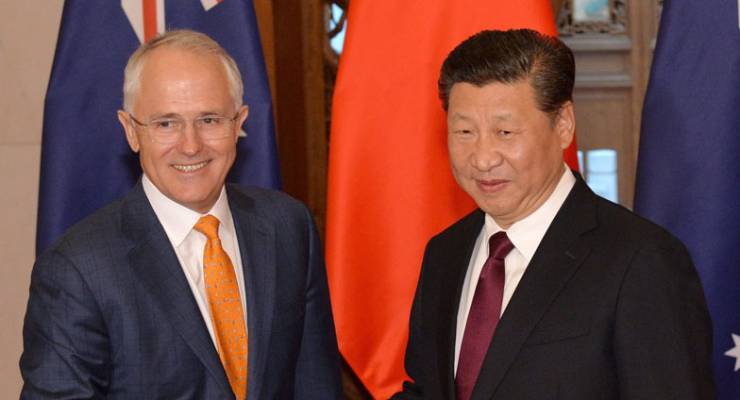
There’s an economic elephant in the vast, featureless waiting room that is the 2016 Australian election campaign: the Chinese economy.
No other developed nation on the planet is so reliant on China as a customer, and the prices of the main goods that Australia sells to the world’s largest economy look set for another hit, as recent optimism that China’s falling growth had stabilised has proven unwarranted.
That optimism was based on the figures inflated by the aforementioned stimulus — some analysts believe that it has been as large in toto as the 2008 stimulus — the medium-term effect of which will be to push China’s debt levels close to breaking.
Yet it is unlikely you will hear either Malcolm Turnbull and Scott Morrison, or Bill Shorten and Chris Bowen, issue what should be warnings of some gravitas over China and its implications for Australia. The reason for this is that the reality coming down the track makes a mockery of the financial projections of both sides.
[Turnbull to keep whirlwind China trip to just business]
The numbers that will start coming out of China in the second half of the year will mark a return to harsh reality, as the latest Beijing-sanctioned credit binge — and the country’s short-lived appearance of stability — stutters and then slows. The recent surge in commodities prices has proven the Indian summer is what it was always going to be.
It is now also clear that those in the Chinese government are gravely concerned about the economy, as they fully realise how difficult it is to manage a controlled downturn and institute real reforms (compared to unleashing go-go growth using a combination of basic measures like allowing private enterprises to operate and flourish, opening the country up to the global economy and implementing a mercantilist currency policy that kept Chinese exports cheap).
What to do about reforming and restructuring the economy in China? Promised with a bang by the Communist Party at the end of 2013 but barely begun, the issue has now become a front-page debate in the one-party state. Oddly, the same debate here has only been dealt with in empty slogans such as “jobs and growth” and piecemeal reform in dribs and drabs, targeted at certain voter groups.
Chinese corporate debt a sticking point
Although China’s total debt of around 225% of gross domestic product isn’t particularly high by global standards, its corporate debt at approximately 145% of GDP is high by any measure, the IMF says.
“Mounting corporate debt is a key fault line in the Chinese economy,” David Lipton, the IMF’s first deputy managing director, said. “Corporate debt remains a serious — and growing — problem that must be addressed immediately and with a commitment to serious reforms.”
But the structural changes China must finally commence — such as ripping out excess industrial capacity, reform of state-owned enterprises that still dominate key sectors, and reforming a banking system where interest rates are structured so consumers subsidise the state — are taking an increasing toll on its demand for Australian resources. The potential implications for Treasury revenues and Australia’s budget deficit are enormous.
Shame, particularly, on Malcolm Turnbull, who famously promised in his rousing speech fresh from his party room victory over Tony Abbott that he wanted to have “grown-up” conversations with Australians. Yet here is a government that has based its budget on fairy tales.
Take the price of iron ore, Australia biggest export. The budget has a forecast of US$55 per tonne. Last Friday, it closed at US$50.70, the same as its monthly average — so far down $6.8 per tonne. Futures markets have it $10 per tonne lower and each US$5 drop wipes billions off the budget.
The problem with GDP
Talk to any economist with half a brain and they will tell you why GDP is increasingly a poor measure of economic health.
It only measures raw output, not the quality or efficiency of that output, whether spending is being made on things with high costs and it takes no account of things that have a longer term impact, like income trajectories and demographic changes. And of course, given Australia’s strong economic links with China, especially when it comes to raw output, Chinese stimulus has a direct positive impact.
So, in fact, the first quarter’s 3% was no surprise to anyone who understood the scale of China’s pump-priming. But of course GDP figures are a questionable short hand of an economy’s strength. How can any one number explain the complexities of economy? Yet in these days of between GDP inflation and unemployment the economy appears simply summed up. Perhaps. But they are descriptions of the past rather than where the economy is heading. Scratch the surface of the top line figures and there were plenty of concerning statistics, lead by falling real incomes.
But China’s latest round of pump-priming appears to be coming to an end and that’s bad news for Australia’s still heavily resources-dependent exports.
[She won’t be right: Australian economy will sink with China’s]
Of course it’s right to focus on the good news and the abundant opportunity that is still available from China, particularly in agriculture, tourism, health supplements, niche services sectors — only niche, mind you — and, although to a far lesser extent than the government likes to talk up, education.
But these things are all small beer compared with resources. As well, the Chinese economy is the biggest factor in the almost universal softening of economic growth and demand for Australia’s ever-cheaper resources around the region; like Australia, just about every country in Asia’s east and south-east has China as its No. 1 trade partner. This is particularly true of Australia’s second and third largest resources customers: Japan, which also has its own set of problems that have led to its seemingly intractable economic flat-lining, is Australia’ second biggest resources export market; South Korea is third.
Australian budget devoid of substance
As noted, Scott Morrison’s budget contains, in the view of most economists, a “heroic” assumption. And yet it is from this document that both political parties project their economic “plans” — the appropriately bland term now in vogue in place of vision.
Once again, Treasury has over-estimated the strength of the Chinese economy, in particular. That means that whoever wins on July 2 will have to, possibly as early as the December Mid-Year Economic and Fiscal Outlook statement, start having the grown-up conversations with the electorate about China and how deeply that is already affecting, and will continue to affect the Australian economy.
It’s a shame that the Australian government and opposition are devoid of any substance and fearful of tough leadership, and worse still, possibly ill-informed.
Rather than gilding the lily during election campaign, the harsh realities charging headlong for the Australian economy should be honestly explained, together with policies to at least ameliorate their affect — and this starts with China, so that voters can make their choices based on realistic economic forecasts rather than two pies in the sky.








I like pie.
The upside to the LNP winning the next election is the likelihood that they won’t be able to get anything through the senate, and the probability of Australia meeting some formidable headwinds in the economy that might finally drag the unknowing Aust. public away from the idea that these guys have any economic nous at all.
As if the brittle fragility of the international monetary system has not been demonstrated by the US subprime con and for the bijou version Grexit for the EU, it will really knock off several dozen pairs of socks when the Chinese hit the wall of “let’s pretend”.